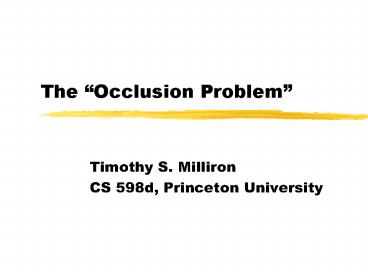The PowerPoint PPT Presentation
Title: The
1
The Occlusion Problem
- Timothy S. Milliron
- CS 598d, Princeton University
2
What is the Occlusion Problem?
- Between two images, occlusion relationships might
change unpredictably - Background might be exposed
- Holes in surfaces might result.
- IBR needs more information to avoid artifacts
- Chen Williams Associate a depth-image with
each RGB image.
3
Another Approach
- Use depth information to generate something more
like a traditional mesh - Perform a 3-D warp on the texture-mapped mesh
(which looks just like the image). - Traditional Z-buffering will (almost) solve the
occlusion problem.
4
Mark, McMillan, Bishop
- Application
- Increase frame-rates from 5 FPS to 60 FPS for
expensive scenes - Obtain good remote display performance
- Approach
- Render a few frames traditionally (reference
frames) per second, interpolate the rest.
5
Solving the Occlusion Problem
- Treat the image as a texture-mapped triangular
mesh with depth encoded in the Z coordinate. - To interpolate, perform a standard 3-D warp using
triangulation and geometry - Depth-buffering should suffice to solve occlusion
and ensure no holes in surfaces - But ...
6
Rubber Sheets
- At object edges, triangles can be perpendicular
to image plane, between foreground and
background. - Cause problems for occlusion
- Solution Tag triangles as connected connected
triangles are part of a surface - Complicated calculation
- Okay, but
7
Undersampling
- If a surface is oblique to the camera in one
reference frame, and the derived frame shows the
surface head-on, the surface is undersampled - Holes in the surface result
- Solution confidence value for each pixel
- Measures how well a given view can see a surface
8
View-Based Rendering
- Application
- Viewing an arbitrary real-world object in 3-D
from a concentric sphere around the object. - Spherical lumigraph
- Approach
- Use range-images to generate view-dependent
triangular meshes to approximate the surface. - Texture-map the surface with the acquired image
- Composite multiple views to form novel viewpoints
and solve occlusion.
9
Soft Z-Buffering
- To composite the meshes
- If the z-values are not within some threshold,
use the closest - If they are, blend them, using three weights
10
Weights (1)
- First Weight Distance from reference image
(like Gouraud triangle interpolation) (corrects
for image distortion)
11
Weights (2)
- Obliqueness to camera (corrects for holes)
- Prefer head-on images to oblique images
12
Weights (3)
- Distance from mesh boundary (less confident at
the boundary) (corrects for polygonal error)
13
Summary
- All IBR technologies that incorporate translation
must solve the occlusion problem. - There are various approaches
- Purely image-based (RGB and Z-buffer)
- Partially geometry-reconstructing (meshes and 3-D
warps) - Special considerations
- Using existing graphics hardware.

